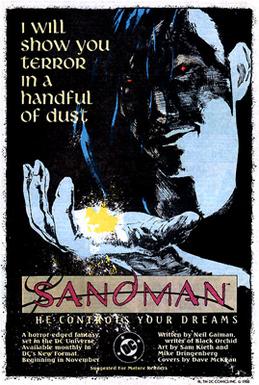
Neil Richard MacKinnon Gaiman is an English author of short fiction, novels, comic books, graphic novels, nonfiction, audio theatre, and films. His works include the comic book series The Sandman and novels Stardust, American Gods, Coraline, and The Graveyard Book. He has won numerous awards, including the Hugo, Nebula, and Bram Stoker awards, as well as the Newbery and Carnegie medals. He is the first author to win both the Newbery and the Carnegie medals for the same work, The Graveyard Book (2008). In 2013, The Ocean at the End of the Lane was voted Book of the Year in the British National Book Awards.
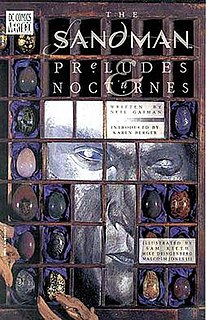
Preludes & Nocturnes is the first trade paperback collection of the comic book series The Sandman, published by the DC Comics imprint Vertigo. It collects issues #1–8. It is written by Neil Gaiman, illustrated by Sam Kieth, Mike Dringenberg and Malcolm Jones III, colored by Robbie Busch and lettered by Todd Klein.

Dream Country is the third trade paperback collection of the comic book series The Sandman, published by DC Comics. It collects issues #17–20. It is written by Neil Gaiman, illustrated by Kelley Jones, Charles Vess, Colleen Doran and Malcolm Jones III, coloured by Robbie Busch and Steve Oliff, and lettered by Todd Klein.
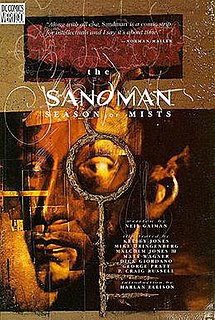
Season of Mists is a 1990-1991 American seven-part comic and the fourth collection of issues in the DC Comics' The Sandman series. It collects issues #21–28. It was written by Neil Gaiman; illustrated by Kelley Jones, Mike Dringenberg, Malcolm Jones III, Matt Wagner, Dick Giordano, George Pratt, and P. Craig Russell; coloured by Steve Oliff and Daniel Vozzo; and lettered by Todd Klein.

Fables & Reflections (1993) is an American fantasy comic book, the sixth collection of issues in the DC Comics series The Sandman. It was written by Neil Gaiman and illustrated by Bryan Talbot, Stan Woch, P. Craig Russell, Shawn McManus, John Watkiss, Jill Thompson, Duncan Eagleson, Kent Williams, Mark Buckingham, Vince Locke and Dick Giordano, coloured by Daniel Vozzo and Lovern Kindzierski/Digital Chameleon, and lettered by Todd Klein. The introduction is written by Gene Wolfe.

The Wake is the tenth and final collection of issues in the American comic book series The Sandman. It is written by Neil Gaiman, illustrated by Michael Zulli, Jon J. Muth and Charles Vess, colored by Daniel Vozzo and Jon J. Muth, and lettered by Todd Klein.
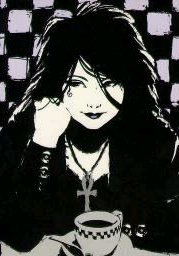
Death is a fictional character from the DC comic book series, The Sandman (1989–1996). The character first appeared in The Sandman vol. 2, #8, and was created by Neil Gaiman and Mike Dringenberg.
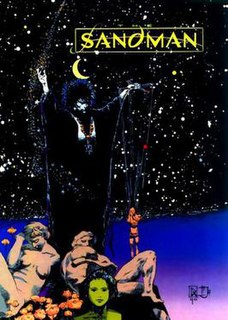
Dream is a fictional character who first appeared in the first issue of The Sandman, written by Neil Gaiman and published by DC Comics. One of the seven Endless, inconceivably powerful beings older and greater than gods, Dream is both lord and personification of all dreams and stories, all that is not in reality. He has taken many names, including Morpheus and Oneiros, and his appearance can change depending on the person who is seeing him. Dream was named the sixth-greatest comic book character by Empire Magazine. He was also named fifteenth in IGN's 100 Top Comic Book Heroes list.

Vertigo was an imprint of the American comic book publisher DC Comics. It was created in 1993 to publish stories with more graphic or adult content, which did not fit within the restrictions of the Comics Code Authority or DC's primary superhero brand, thus allowing more creative freedom. These comics were free to contain explicit violence, substance abuse, sexuality, nudity, profanity, and other controversial subjects, similar to films and TV shows intended for adult audiences. Following a series of editorial restructurings in the 2010s, DC discontinued it in January 2020, instead publishing later "mature readers" work under the "DC" label.
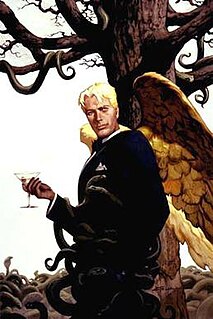
Lucifer Samael Morningstar is a fictional superhero character appearing primarily as a supporting character in the comic book series The Sandman and as the title character of a spin-off. Though various depictions of Lucifer—the Biblical fallen angel and devil of Christianity—have been presented by DC Comics in their run, this interpretation by Neil Gaiman debuted in The Sandman in 1989. Lucifer Morningstar is one of the most powerful beings in the DC Universe.
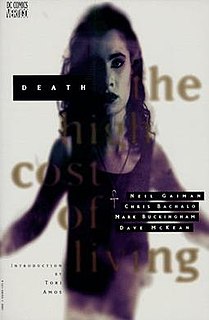
Death: The High Cost of Living is a comic, written by Neil Gaiman with art by Chris Bachalo and Mark Buckingham. It is a spin-off from Gaiman's best-selling Vertigo Comics series The Sandman, featuring the Sandman (Dream)'s elder sister, Death of the Endless. Its premise is that Death takes human form once a century, to remain grounded and in touch with humanity, an idea touched upon in several other media, for example in the 1934 film Death Takes a Holiday and in the Terry Pratchett novel Reaper Man.

Colleen Doran is an American writer-artist and cartoonist. She illustrated hundreds of comics, graphic novels, books and magazines, including the autobiographical graphic novel of Marvel Comics editor and writer Stan Lee entitled Amazing Fantastic Incredible Stan Lee, which became a New York Times bestseller. She adapted and did the art for the short story "Troll Bridge" by Neil Gaiman, which also became a "New York Times" bestseller. Her books have received Eisner, Harvey, Bram Stoker, and International Horror Guild Awards.

Michael Zulli is an American artist known for his work as an animal and wildlife illustrator and as a comic book illustrator.
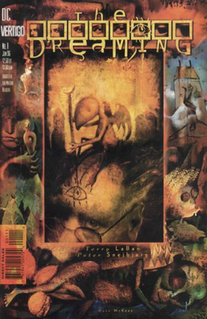
The Dreaming is a fictional place, a comic book location in the DC Universe. The Dreaming first appeared in the Sandman vol. 2 #1, and was created by Neil Gaiman and Sam Kieth. The Dreaming is the domain of Dream of the Endless.

The Little Endless Storybook is a picture book by Jill Thompson published by the Vertigo imprint of DC Comics. It features the popular Endless characters from Neil Gaiman's The Sandman comic book reimagined as toddlers. A second Little Endless Storybook, titled Delirium's Party, was released in 2011.
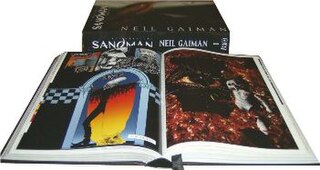
DC Comics Absolute Edition is a series of archival quality printings of graphic novels published by DC Comics and its imprints WildStorm Productions and Vertigo. Each is presented in a hardcover, dustjacketed and slipcased edition with cloth bookmark consisting of one or more books which include restored, corrected and recolored versions of the original work, reprinted at 8 inches by 12 inches. Also included are supplemental materials regarding the creation of the work, including sketches, comic scripts and memos.

The Endless are a group of fictional beings appearing in American comic books published by DC Comics imprint Vertigo. The characters embody powerful forces or aspects of the DC Universe in the comic book series The Sandman, by Neil Gaiman. They have existed since the dawn of time and are thought to be among the most powerful beings in the existence. They are distinct from and more powerful than most gods. Dream is the protagonist of The Sandman series, but all of the Endless play major roles.

The Sandman Universe is a line of American comic books published by DC Comics under its imprints DC Vertigo and DC Black Label. The line launched to celebrate the 30th anniversary of Neil Gaiman's The Sandman (1989—1996) and Vertigo's 25th anniversary. The Sandman Universe began in August 2018, with a titular one-shot, which was followed by four ongoing series—House of Whispers, Lucifer, The Books of Magic, and The Dreaming. Each comic is overseen by Gaiman but written by new creative teams.

